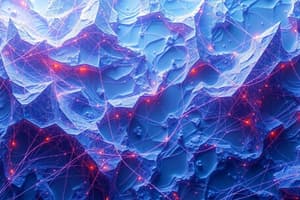Podcast
Questions and Answers
Who is the author of the book 'Additive Manufacturing Technologies'?
Who is the author of the book 'Additive Manufacturing Technologies'?
- Ian Gibson, David Rosen, Brent Stucker (correct)
- Ian Gibson, Michael Brown, Olivia Davis
- David Rosen, Brent Stucker, Emily White
- Ian Gibson, John Smith, Sarah Johnson
In which country is Deakin University located?
In which country is Deakin University located?
- Canada
- United Kingdom
- Australia (correct)
- United States
Which institution is David Rosen affiliated with?
Which institution is David Rosen affiliated with?
- Stanford University
- Georgia Institute of Technology (correct)
- Massachusetts Institute of Technology
- Harvard University
What is the ISBN of the eBook version of the book?
What is the ISBN of the eBook version of the book?
What is the term used for Automated Fabrication?
What is the term used for Automated Fabrication?
Which technology is associated with Vat Photopolymerization Processes?
Which technology is associated with Vat Photopolymerization Processes?
What is the first step in the Generic AM Process?
What is the first step in the Generic AM Process?
What technology is used for Reverse Engineering?
What technology is used for Reverse Engineering?
What is the term used for Freeform Fabrication?
What is the term used for Freeform Fabrication?
Which technology is associated with Metal Systems in AM?
Which technology is associated with Metal Systems in AM?
What is the main focus of the book on Additive Manufacturing (AM)?
What is the main focus of the book on Additive Manufacturing (AM)?
What is the collective experience of the authors in the field of AM?
What is the collective experience of the authors in the field of AM?
What is a key advantage of AM machines?
What is a key advantage of AM machines?
What do the first three chapters of the book provide?
What do the first three chapters of the book provide?
How many chapters are dedicated to detailing each group of AM technologies?
How many chapters are dedicated to detailing each group of AM technologies?
What do the final chapters of the book focus on?
What do the final chapters of the book focus on?
What is the target audience for the 2nd edition of the book on Additive Manufacturing?
What is the target audience for the 2nd edition of the book on Additive Manufacturing?
What new content is included in the 2nd edition of the book?
What new content is included in the 2nd edition of the book?
What technological innovations are covered in the 2nd edition?
What technological innovations are covered in the 2nd edition?
How is the terminology updated in the 2nd edition?
How is the terminology updated in the 2nd edition?
How has the original chapter on printing processes been modified in the 2nd edition?
How has the original chapter on printing processes been modified in the 2nd edition?
What is the focus of the 2nd edition compared to the first one?
What is the focus of the 2nd edition compared to the first one?
Flashcards are hidden until you start studying
Study Notes
Additive Manufacturing: 2nd Edition Preface Summary
- The 2nd edition of the book on Additive Manufacturing (AM) is aimed at students, educators, and researchers, offering depth for undergraduate and graduate-level courses.
- The book includes exercise questions for readers and a companion instructor's guide, and it is useful for researchers to understand the state of the art and opportunities for further research.
- The 2nd edition includes new sections and chapters, an extended chapter on medical applications, a new chapter on rapid tooling, and discussions on recent movements in the low-cost AM sector.
- Technological innovations, including the new Additive Manufacturing File Format and standardization of AM with ASTM and ISO, are covered in the 2nd edition.
- The text has been updated to conform to terminology developed by the ASTM F42 committee, adopted as an ISO international standard, and references to company-specific technologies have been reduced.
- The original chapter on printing processes has been split into two chapters on material jetting and binder jetting to reflect standard terminology and the evolution of these processes in different directions.
- The 2nd edition is significantly more comprehensive than the first one, with the removal of company-specific references and a focus on technological principles and general understanding.
- The authors recognize that the rapidly changing technology may render the book outdated and offer additional homework exercises and aids for educators on the course website.
- The authors are established experts in Additive Manufacturing with many years of research experience, and the book is made possible by the collaboration with students and colleagues.
- Dr. Brent Stucker, one of the authors, acknowledges the support from various institutions and individuals, including Utah State, VTT Technical Research Center of Finland, and the University of Louisville, as well as graduate students and postdoctoral researchers.
- Dr. Stucker's wife and children are also acknowledged for their patience and support during the creation of the book.
- The preface ends with brief author biographies and acknowledgments, providing context for the authors' expertise and the collaborative efforts that contributed to the book.
Studying That Suits You
Use AI to generate personalized quizzes and flashcards to suit your learning preferences.




